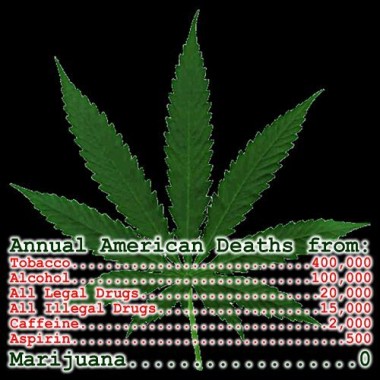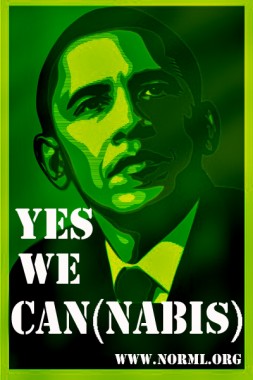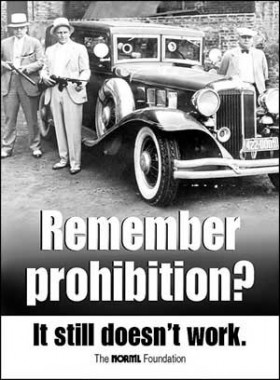A New Direction in US Medical Marijuana Policy
Don’t let the rasta cap I wear fool you: I’m not a pot smoker. Oh, I’ve tried it. I even inhaled. It just gave me the munchies and made it hard for me to remember what I was talking about, which is hard enough on general principle. Nonetheless, when Attorney General Eric Holder announced Feb. 27 that the federal government was to stop the raids on state-approved marijuana dispensaries, it brought a tear of joy to my eyes. Why? Because my best friend is among those people for whom marijuana is a miracle medicine. THE PHARMA-GO-ROUND
My friend suffers from schizoaffective disorder, which is basically schizophrenia accompanied by a mood disorder, like bipolar. Bipolar disorder is what they used to call manic-depression, an illness marked by periods of severe depression and excessive, often dangerously unbounded energy. Since his diagnosis, he’s been through the gamut of available atypical (i.e., second generation) antipsychotic drug combinations…Risperdal, Geodon, Abilify, Zyprexa, Seroquel, and others. And while he was taking these various combinations, receiving what passes in our nation today as medication management by community mental health centers, he still continued to sporadically hear voices, experience mania, paranoid delusions, and the whole nine yards. Although mental health professionals and the pharmaceutical companies who sponsor them proclaim that great strides have been made in recent years with these new antipsychotic drugs, in my friend’s case, the results have been short-lived, at best. The prevailing theory is that schizophrenic psychosis is caused by an excess of the chemical messenger dopamine in the brain; antipsychotic drugs work by blocking the dopamine receptors, and typically require 6 or 8 weeks to take effect. They can lessen the symptoms for a while in periods which vary from individual to individual. However, over time, research shows that the brain realizes that it’s been tampered with, and in order to “right†itself, simply sensitizes the remaining working receptors that it has in order to receive more dopamine, lessening the long-term efficacy of the drugs. Patients often hop from drug to drug in order to circumvent this outcome, or stop taking them for periods of time, and the prognosis is less than stellar. The fine print in the antipsychotic insert sheets reveals that most of the drug studies only cover three month periods, anyway (“effectiveness…in longer-term use, that is, more than 12 weeks, has not been systematically evaluated in controlled trials”), and that “the smallest dose and the shortest duration of treatment producing a satisfactory clinical response should be sought”, though no psychiatrist will ever tell you this. CANNABIS: THE ORGANIC ANTIPSYCHOTIC
Over the four years that I’ve known him, I’ve observed that it was only when my friend was able to access marijuana that his symptoms would lessen for any length of time. When he’d get his bag, the compulsive laughing would cease; the pacing would subside. He was actually able to sleep at night and focus on the world around him, rather than just the one inside his head. He spoke less about aliens and more about gardening. The change was like night and day, apparent in hours rather than weeks. You didn’t have to be a professional to recognize it. What’s more, he reacted differently than I do to its effects. He didn’t turn into a stoned zombie who couldn‘t remember his name. In fact, it had the opposite effect. There is science out there to explain its benefits, but for some reason, we don’t hear about this research so much. Even so, European studies have determined that cannabidiol, one of the non-intoxicating ingredients of marijuana, provides substantial antipsychotic properties for the treatment of acute schizophrenia, matching that of atypical antipsychotics. Moreover, it does so without the side effects associated with more traditional medication, which can include excessive weight gain, hyperglycemia, diabetes, Reyes syndrome, cancer, Parkinson-like symptoms, tardive dyskinesia (involuntary facial grimacing and hand tremors), akathisia (inability to sit still), neuroleptic malignant syndrome (NMS), and even sudden death. Contrary to popular belief, most newer antipsychotics are no better than the older ones when it comes to side effects (aka “extra-pyramidal symptoms”). Marijuana, in contrast, is decidedly less risky.
I also have other friends who have benefitted from marijuana use for conditions ranging from personality disorders to cancer. In addition to its antipsychotic value, it has also been shown to shrink tumors. Unfortunately, cannabidiol is not available as a prescription in the US, and it may well be that other heretofore unstudied components in the plant contribute to its effectiveness. It does bear noting that discontinuing pharmaceutical antipsychotics is not necessarily the answer. If it works, don’t fix it. And stopping cold-turkey with super-sensitized dopamine receptors can be disastrous and lead to acute symptoms. Just make sure you know the benefits and the risks, and find a professional who is willing to give you a realistic picture. Of course, don’t expect them to laud the benefits of medical marijuana. The promotional office notepads, mousepads and calendars don’t have cannabis leaf emblems on them, after all. THE BREAKFAST OF CHAMPIONS?
CHANGE WE CAN BELIEVE IN
President Bush’s drug policy was largely a lock-em-up and throw away the key approach, and for years, millions and millions of our tax dollars were used to convict, house and feed marijuana users and to raid state dispensaries which provided it for certain populations.
However, during the recent presidential campaign, the winds of change began to blow: then-candidate Barack Obama, when asked about his policy on medical marijuana, stated, “My attitude is if the science and the doctors suggest that the best palliative care and the way to relieve pain and suffering is medical marijuana, then that’s something I’m open to. There’s no difference between that and morphine when it comes to just giving people relief from pain.†Thankfully, in my opinion, Barack Obama is now our President, and he’s proving to be a man of his word. And now, instead of being stuck with “the Deciderâ€, we have someone in Washington who is finally listening to the people, who in large majorities have strongly advocated marijuana policy reform. On Friday, White House Spokesman Nick Shapiro, recognizing California’s medical marijuana program, stated that the Obama administration’s position was that “federal resources should not be used to circumvent state laws.†The door has now been opened for even more sweeping policy changes in the future, which I feel are desperately needed. TIME FOR A CLINIC NEAR YOU
Medical marijuana programs are in place in only 14 states, whose criteria for approval varies from location to location. Florida has no such program. Whereas my friend was able to use a doctor’s letter in Los Angeles to walk around the block and safely purchase his medicine from a neighborhood dispensary, Miami, in turn, offers neither safe nor legal access. Even when he’s been able to find people to get it for him, he’s been overcharged and frequently short-changed. However, after Friday’s announcement, there’s hope in the air for my friend and those like him. States with bills floating around their legislatures may now be emboldened to push them through. Not only will it prevent needy patients from having to go without it, it will also take away a valuable commodity from the hands of gangs and organized crime. THE GREEN SOLUTION TO AN AILING ECONOMY The situation in which we find ourselves today is remarkably similar to the one we experienced in the Great Depression. In those days, prohibition was the law of the land, and bootleg liquor was a main industry for mobsters, many of the proceeds of which, ironically enough, went to the construction of South Beach’s Art Deco District. However, when prohibition was repealed by President Franklin Delano Roosevelt in 1933, it took the money out of the hands of the mobsters, and brought an influx of millions of new tax dollars into the economy which helped our country recover from the Depression.
Today, the decision is an even easier one: in addition to providing a much-needed boost for our economy and taking power away from gangs, cartels and other organized crime, we can also reduce government spending and alleviate the physical and mental suffering of millions of our citizens. I only wish the rest of life was this simple. What we can do to bring medical marijuana to Florida: write to legislators and join advocacy groups like norml.org. Plan local medical marijuana advocacy get-togethers on meetup.com and work with lawmakers to find solutions that address their concerns while finding ways to make cannabis available for those who can benefit from it. Help bring this drug out of the ghetto and into the pharmacies!
You Deserve More Than an Ordinary Vacation.
Travel with Miami Beach 411 Today!
The Miami Beach 411 Travel Store is Open 24/7.
12 Comments on"A New Direction in US Medical Marijuana Policy"
|

Like what you see? Let's talk about how
we can help your vacation --> Contact Us |
|
Like what you see? Let's talk about
how we can help your vacation
--> Contact Us
how we can help your vacation
--> Contact Us

























Friendly Universe says:
I wonder if the Obama administration will reinstate the federal Investigational New Drug (IND) Program that Bush instructed the DEA to crack down on. I guess that pre-Bush, this was a compassionate program for people who lived in non-medical marijuana states to apply for and receive federal marijuana. If so, maybe this is something Dave could apply for while the Florida legislature is getting its act together (wouldn’t hold my breath).
Posted on 03/09/2009 at 12:34 PM